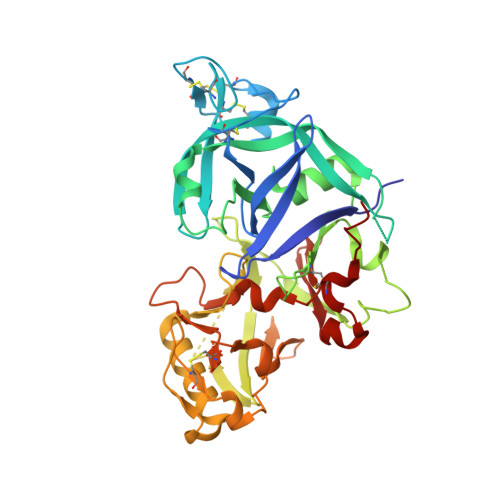Crystal structure of basic 7S globulin, a xyloglucan-specific endo-beta-1,4-glucanase inhibitor protein-like protein from soybean lacking inhibitory activity against endo-beta-glucanase
Yoshizawa, T., Shimizu, T., Yamabe, M., Taichi, M., Nishiuchi, Y., Shichijo, N., Unzai, S., Hirano, H., Sato, M., Hashimoto, H.(2011) FEBS J 278: 1944-1954
- PubMed: 21457461
- DOI: https://doi.org/10.1111/j.1742-4658.2011.08111.x
- Primary Citation of Related Structures:
3AUP - PubMed Abstract:
β-Linked glucans such as cellulose and xyloglucan are important components of the cell walls of most dicotyledonous plants. These β-linked glucans are constantly exposed to degradation by various endo-β-glucanases from pathogenic bacteria and fungi. To protect the cell wall from degradation by such enzymes, plants secrete proteinaceous endo-β-glucanases inhibitors, such as xyloglucan-specific endo-β-1,4-glucanase inhibitor protein (XEGIP) in tomato. XEGIPs typically inhibit xyloglucanase, a member of the glycoside hydrolase (GH)12 family. XEGIPs are also found in legumes, including soybean and lupin. To date, tomato XEGIP has been well studied, whereas XEGIPs from legumes are less well understood. Here, we determined the crystal structure of basic 7S globulin (Bg7S), a XEGIP from soybean, which represents the first three-dimensional structure of XEGIP. Bg7S formed a tetramer with pseudo-222 symmetry. Analytical centrifugation and size exclusion chromatography experiments revealed that the assembly of Bg7S in solution depended on pH. The structure of Bg7S was similar to that of a xylanase inhibitor protein from wheat (Tritinum aestivum xylanase inhibitor) that inhibits GH11 xylanase. Surprisingly, Bg7S lacked inhibitory activity against not only GH11 but also GH12 enzymes. In addition, we found that XEGIPs from azukibean, yardlongbean and mungbean also had no impact on the activity of either GH12 or GH11 enzymes, indicating that legume XEGIPs generally do not inhibit these enzymes. We reveal the structural basis of why legume XEGIPs lack this inhibitory activity. This study will provide significant clues for understanding the physiological role of Bg7S.
Organizational Affiliation:
Graduate School of Nanobioscience, Yokohama City University, Japan.














